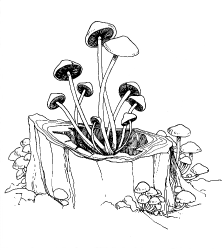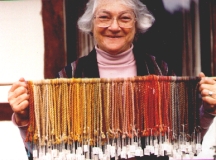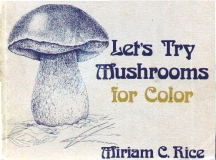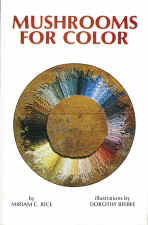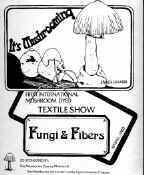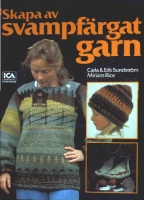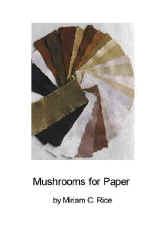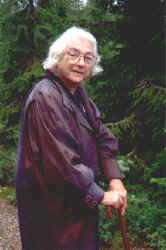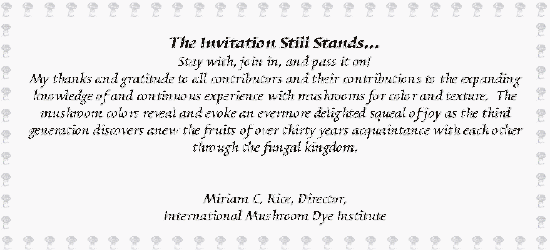A Brief History of the Art of Mushroom Dyeing |
© Dorothy M. Beebee |
In the
beginning, |
|
| Miriam took a clump of sulphur
yellow Naematoloma fasciculare mushrooms, and tossed them into a dye
pot with a bit of wool yarn. Fortunately, (for all of us,) this action resulted in a
clear bright lemon yellow dye and voilá “mushroom
dyeing” was born! 1972 was a
bumper crop year for mushrooms in California, and Miriam experimented with everything
she found, attending all of the mushroom fairs and forays to identify the mushrooms she
was using, while gradually building up a vast collection of labeled mushroom dyed fiber
samples. |
|
Miriam C. Rice |
In 1973, a weaver friend encouraged Miriam to contact Thresh Publications in Santa Rosa, CA (a small publisher which had done several lovely little books on spinning, dyeing, and weaving) and show them her dye samples. Robert and Christine Thresh encouraged Miriam to write up her experiences and experiments. While teaching a class in textile arts at College of Redwoods in Fort Bragg, CA, she introduced the concept of using mushrooms for natural dyes. She encouraged the weavers, by using |
| cardboard and other simple looms, to
weave entirely with Mushroom Dyed yarns. Many of these pieces were photographed and
appeared later in her little book. Meanwhile, the Threshes introduced Miriam to Dorothy Beebee, who agreed to do pen/ink illustrations of the mushrooms for Miriam’s book, thus beginning a long, flourishing, working relationship. Dorothy had been doing natural dyes and spinning since 1959, while working as a freelance scientific illustrator, and this was a natural combination of the best of both worlds for her too! |
|
| So, the wonderful little book, "Let’s Try Mushrooms for Color" by Miriam C. Rice, was published by Thresh Publications, Santa Rosa, CA in November 1974, while Miriam continued to experiment further and teach workshops in mushroom dyeing. A museum display of the book and its mushroom dyed weavings was conceived, and the exhibit "Natural Dyeing with Fungi" was opened in Willits, CA in August 1976. |
|
| Miriam continued to discover even more brilliantly hued mushroom dyes. In late 1974, while the book was literally going to press, she discovered astonishing, rose, burgundy, and purple hues emerging from a "mysterious" mushroom found growing under the Bishop pines in Mendocino County. Samples of these mushrooms, (tiny remnants literally scraped out of the dye pot), were sent to be microscopically identified in April, 1974 by Dr. Daniel Stuntz and Dr. Susan Libonati-Barnes at the University of Washington. They were identified as members of the genus Cortinarius. |
| Lovely purple, blue and green hues emerged from other mushrooms, continuing to enchant and inspire weavers far and wide, and this widely expanded palette of extraordinary dye color evolved into a new book documenting the expanded research by Miriam. "Mushrooms for Color" was published in 1980 by Mad River Press, Eureka, CA. in 1980, a contribution on the chemistry of the mushroom pigments by Dr. Erik Sundström was added in a later edition. |
|
|
In the Summer of 1980, the "1st International
Mushroom Dyes Textile Show - FUNGI and FIBERS", was announced, (This exhibit
had become "international" because there was one mushroom-dyed piece contributed
from a weaver in Canada!) Miriam has continued to experiment with many new mushroom dyes, revised her thinking on the toxicity of many mordants, she now advocates the use of only alum and iron mordants, |
| and has experimented with pH factors. She has also given many mushroom dye workshops and lectures all over the USA, Canada, and at Fungus & Fibre Symposia in Sweden, Norway, Scotland, Denmark and most recently in 2001 at Rovaniemi, Finland. | |
| Meanwhile, Dorothy had shared her mushroom dyeing enthusiasm mushroom with her friend from college days, Carla Sundström, and her husband Erik, sending these avid amateur mycologists a copy of Miriam’s first book when it was published in1974. This in turn inspired the Sundströms to experiment with mushroom dyes in Sweden, beginning a lively correspondence and exchange of knowledge across the oceans, which continues to this day. The experiments by the Sundströms evolved into a book about the comparable mushroom dyes of Sweden, which, for the sake of continuity in the mushroom dye research, Dorothy was then invited to Sweden to illustrate. | |
| In 1982, the book Färga med svampar, by Carla and Erik Sundström was published by ICA bokförlag, Västerås, Sweden. This book was inspired and based on the work by Miriam C. Rice. The resulting enthusiasm by the fiber art conscious Swedes led to their invitation to sponsor another "International Fungus and Fiber Exhibition" in 1983, this time in Stockholm, Sweden. |
|
|
After the 1983 Symposium, the Sundströms collaborated on a book with Miriam Rice in 1984, as a celebration of the many lovely mushroom-dyed fiber art pieces woven, knitted, felted and crocheted over the last 10 years of mushroom dye experiments in North America and in Scandinavia. Skapa av Svampfärgat Garn by Carla and Erik Sundström and Miriam C. Rice., published by ICA bokförlag The authors then jointly decided to invest a portion their royalties from this book into the formation of a non-profit organization for educational purposes and the promotion of mushroom dyes. Thus THE INTERNATIONAL MUSHROOM DYE INSTITUTE was established in 1985. |
These commitments are just as urgent in 2002 as they were in 1985! For more IMDI information or contact Dorothy Beebee |
Miriam has continued to experiment with many new mushroom dyes, revised her thinking on the toxicity of many mordants, (she now advocates the use of only alum and iron mordants), experimented with pH factors, and included new section, contributed by Dr. Erik Sundström, on the chemistry of Mushroom Pigments. |
| While experimenting with mushroom dyes back in the 70’s, the possibility of making paper out of the fungal detritus left over from the dyes occurred to Miriam Rice. Always a passionate advocate of Recycling, this seemed to be the natural solution for disposal of the fungal residue from the dye process. She experimented with a few mushrooms for paper, but the fever of the dye experiments prevailed over all until 1985, when she introduced the concept of paper making from fungi in Denmark at the 3rd International Fungi and Fiber Symposium. Papermaking workshops were conducted in 1988 at the 4th International Symposium, in California, |
|
| and again in the 1990 Symposium in Norway.
Miriam published her experiments in the Winter 1991 issue of Mushroom, the Journal.
In 1992, The exhibit of "Let’s Try Polypores for
Paper" caught world-wide attention and another new art form with mushrooms
was officially launched! Well, all of that lovely paper just invited painting, and in 1992, Miriam began experimenting with making watercolor paints from the mushrooms. The results of her experiments were introduced in a 1999 workshop at the 9th International Fungi/Fiber Symposium in Hønefoss, Norway and she continued to enthusiastically experiment with all of the new possibilities in mushrooms for dyes, paper, and pigment! |
| For some time, Miriam had been thinking of using
the mushroom pigments in some form of medium for artists to use in drawing and sketching
to supplement the watercolor paint. Months of experiments resulted in a drawing
medium called Mycostix,© , which Miriam formally introduced in August 2001 at the 10th
International Fungi & Fiber Symposium in Rovaniemi, Finland. She is
currently working on the publication of her newest work in these two fields. |
| Thanks to Miriam’s research and experimentation, the extraordinary Mushroom Dyes and Mushroom Papermaking are now being used and taught by fiber artists world wide, and have been consistently referenced by mycology books over the last 30 years. |
|
The 11th International Fungi/Fiber Symposium was hosted by enthusiastic fiber artists of Western Australia in 2003!! Check out these Webpages (click on icon to right) for a taste of Symposia fare... The 12th Internatonal Fungi/Fiber Symposium was held near Copenhagen, Denmark in August 2005.
The 13th International Fungi/Fiber Symposium will be held once again in the USA, in Mendocino, CA in honor of the pioneering work, life, and 90th birthday of Miriam C. Rice! |
About Mordants – Then and Now… For many years now, due to growing awareness of the toxic nature of some of the mordants we have used in the past (tin, chrome, and copper), our experimentation has shifted to the use of only ALUM and IRON mordants for dyeing. This choice |







